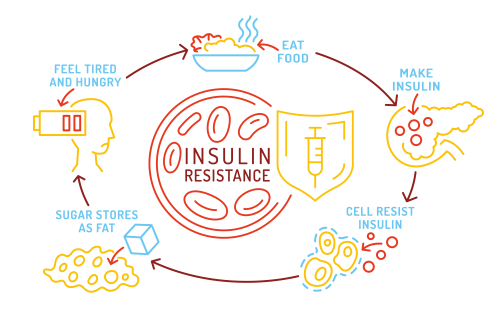You are making an effort. You choose healthier meals. You move more often.
And yet, your weight doesn’t seem to change. It’s frustrating, especially when you live with type 2 diabetes and expect your efforts to pay off.
This is something many people experience. Several processes in your body can work against weight loss, even when you’re eating well. Below you’ll read what might be happening — and how a CGM can help you understand it better.
The Role of Insulin in Fat Storage


Insulin isn’t just the hormone that moves glucose (sugar) from your blood into your cells.
It also signals your body to store energy as fat. When your blood sugar is often high, your body produces more insulin to bring it down.
Higher insulin levels slow down fat burning. Your body gets the message that there’s plenty of fuel available, so it burns less and stores more. As a result, even when you eat less, you may see little to no change on the scale.
Long-term high insulin levels also make it easier for calories to be stored as fat, especially around the abdomen, where your body is most sensitive to insulin.
When Blood Sugar Fluctuations Make Weight Loss Harder
Even if you eat healthy food, your blood sugar can still rise and fall throughout the day.
That can happen when you eat fast-digesting carbohydrates without enough fiber, fat, or protein to slow them down.
Each glucose spike makes your body work harder. Insulin rises to lower your blood sugar, then drops again. That drop can trigger hunger signals, even if you’ve just eaten.
The result? Sudden cravings and extra eating moments without realizing it.
These fluctuations make it more difficult to lose weight because they affect both your appetite and your energy levels.
When Your Body Stops Responding to Insulin
In type 2 diabetes, insulin resistance is often the main issue. Your body still produces insulin, but your cells don’t respond to it properly. As a result, glucose stays in your bloodstream longer.
If you’re insulin-resistant, losing weight becomes much less efficient — even with a healthy diet.
The good news: this process can often be improved. By losing weight, being more active, and keeping your blood sugar more stable, your body can become more sensitive to insulin again.
Research shows that weight loss and regular exercise not only improve glucose levels but also increase insulin sensitivity. That makes it easier to burn fat, and weight loss becomes achievable again.
How a CGM Helps You See What’s Really Going On


Without measurement, you’re guessing.
A Continuous Glucose Monitor (CGM) shows you in real time what’s happening inside your body, during the day and even while you sleep.
Imagine wearing a CGM for just one week.
You’ll see which meals keep your blood sugar high for hours, which types of activity help it drop faster, and how stress or lack of sleep affects your readings.
With that information, you can start experimenting. You might change the order in which you eat, go for a short walk after meals, or try a different breakfast. You’ll instantly see how it impacts your glucose levels.
Scientific studies show that CGM use among people with type 2 diabetes helps improve both weight control and glucose regulation. The power of insight is discovering what truly works for you, not just what’s considered healthy in general.
Many people discover similar patterns once they start using a CGM. Anna, 54, was one of them.
When Anna was diagnosed with type 2 diabetes last year, she made all the right changes or so she thought. She switched to whole-grain bread, cut out soda, and walked every evening. Yet after three months, the scale barely moved, and her energy was still low.
Curious about what was really happening, Anna decided to try a CGM. What she found surprised her.
Her blood sugar spiked every morning after her “healthy” breakfast of oatmeal with banana and honey. The peak lasted for hours, followed by a drop that left her tired and craving snacks before lunch.
With that insight, Anna began to experiment. She replaced the banana with berries, added a handful of nuts, and mixed in Greek yogurt for extra protein.
The difference was immediate. Her glucose levels stayed stable, and she felt full much longer.
Encouraged, she made a few more small changes; a short walk after dinner, more vegetables at lunch, and a consistent bedtime routine. Within two months, her weight began to drop slowly but steadily. Her energy returned, and her glucose readings were the most stable she’d ever seen.
When asked what made the difference, she said:
“Before, I was guessing. With the CGM, I could finally see what my body was trying to tell me.”
Practical Tips to Make Weight Loss Easier
These changes are simple, yet often effective.
- Eat carbohydrates together with fiber, fat, or protein to prevent sharp glucose spikes.
- Move shortly after eating, even a ten-minute walk can make a difference.
- Make sure you get enough sleep, since poor sleep affects the hormones that regulate your blood sugar.
- Avoid foods high in added sugars.
- Change one thing at a time, so you can use your CGM to see what has the biggest effect.
What This Means for You
If your weight isn’t going down despite eating healthy, it’s not a lack of effort.
Your blood sugar, insulin, and your body’s response to food often play a much bigger role than you might think.
A CGM lets you see what’s really happening.
That insight helps you make small, realistic changes that boost your energy and make weight loss truly possible.
The secret to losing weight with type 2 diabetes? Understanding your blood sugar.
Marnix de Haan
Healthcare Blogger & Diabetes Expert
